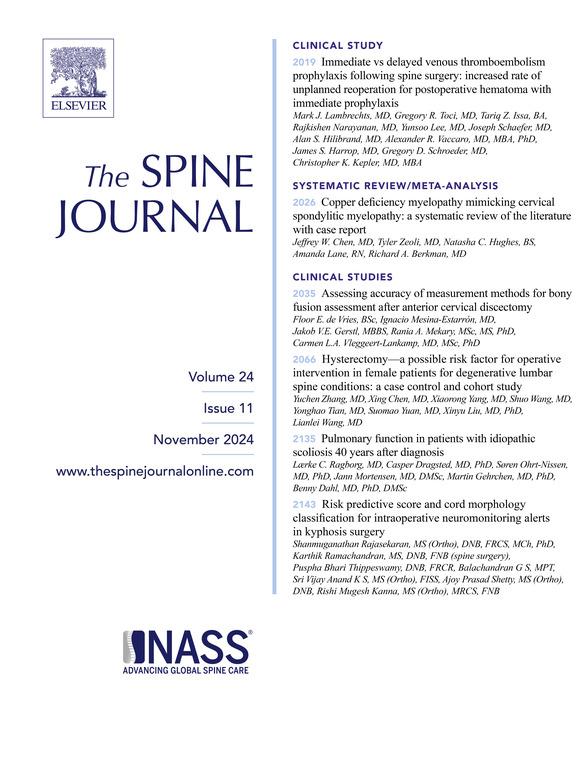2. 与较低患者报告结果相关的健康社会决定因素腰椎手术住院时间较长和慢性阿片类药物使用
IF 4.7
1区 医学
Q1 CLINICAL NEUROLOGY
引用次数: 0
摘要
健康的社会决定因素(SDoH)包括一系列显著影响个人健康结果的环境和个人因素。解决SDoH问题对于改善服务不足人群的患者护理尤为重要,在这些人群中,这些因素具有放大效应。患者报告的结果测量(PROMs)是经过验证的调查工具,为患者的功能状态、生活质量和总体预后提供了有价值的见解。了解SDoH和PROMs之间的关系在脊柱外科中尤为重要,因为患者的预后可能有很大差异。目的:本研究评估SDoH对腰椎手术后术前和术后PROMs的预测作用,以及它们与住院时间的关系。研究设计/设置:回顾性队列研究。患者样本:因腰椎退行性病理在同一家医院接受1或2节段腰椎减压和/或融合的患者。结果测量:患者术前和术后2年完成8项PROMs,包括Oswestry残疾指数(ODI)和PROMIS焦虑、抑郁、疲劳、疼痛干扰(PI)、身体功能(PF)、睡眠障碍(SD)和社会角色(SR)测量。方法对某一机构前瞻性维护的患者数据库进行回顾性分析。纳入了2019年3月至2022年10月期间因腰椎退行性病理接受1级或2级腰椎减压和/或融合的患者。排除标准为缺少SDoH数据或原发癌症诊断。患者术前和术后2年完成8项PROMs,包括ODI和PROMIS测量焦虑、抑郁、疲劳、PI、PF、SD和sr。SDoH变量使用方差分析、t检验和卡方检验进行独立分析。进行单因素和多因素回归分析,以确定PROMs和住院时间的显著预测因素。结果共纳入440例患者,平均年龄64.4岁;44.8%为女性。术后2年,ODI、PROMIS焦虑、PI、PF和SR的改善明显超过了最小的临床重要差异。多变量分析发现5个SDoH因素是术前PROMs恶化的重要预测因素:慢性阿片类药物使用(8/8 PROMs)、残疾(8/8 PROMs)、失业(6/8 PROMs)、退休(5/8 PROMs)和任务代谢当量(METs) (4/8 PROMs)。在术后2年,除退休外,所有这些变量在所有调查领域中仍然是患者报告结果较差的重要预测因素。此外,年龄、METs、黑人种族和慢性阿片类药物使用是住院时间的重要预测因素。区域剥夺指数(Area Deprivation Index, ADI)是一种综合衡量社会经济劣势的方法,将所有SDoH因素整合为一个变量。进一步分析显示,除了PROMIS焦虑,在所有调查领域和时间点,更大的社会经济劣势与更差的术前和术后结果相关。术前(p<0.001)和术后(p<0.001)慢性阿片类药物使用增加也与ADI显著相关。结论:本研究强调了SDoH对腰椎手术患者术前和术后PROMs以及住院时间的重大影响。容易获得的SDoH因素,如阿片类药物的使用和工作状态,可以作为手术结果的有价值的预测因素。识别和解决这些决定因素可以实现更个性化的治疗策略,改善患者的康复,并提高腰椎手术的整体术后结果。FDA器械/药物状态本摘要不讨论或包括任何适用的器械或药物。本文章由计算机程序翻译,如有差异,请以英文原文为准。
2. Social determinants of health associated with lower patient-reported outcomes longer hospitalization in lumbar spine surgery and chronic opioid use
BACKGROUND CONTEXT
Social determinants of health (SDoH) encompass a range of environmental and personal factors that significantly impact individual health outcomes. Addressing SDoH is particularly important for improving patient care in underserved populations, where these factors have an amplified effect. Patient-reported outcome measures (PROMs) are validated survey tools that provide valuable insights into a patient’s functional status, quality of life, and overall prognosis. Understanding the relationship between SDoH and PROMs is especially relevant in spine surgery, where patient outcomes can vary considerably.
PURPOSE
This study evaluates the predictive influence of SDoH on preoperative and postoperative PROMs at a 2-year follow-up after lumbar spine surgery, as well as their association with length of hospitalization.
STUDY DESIGN/SETTING
Retrospective cohort study.
PATIENT SAMPLE
Patients who underwent 1- or 2-level lumbar decompression and/or fusion for degenerative lumbar pathology at a single institution.
OUTCOME MEASURES
Patients completed eight PROMs preoperatively and 2 years postoperatively, including the Oswestry Disability Index (ODI) and PROMIS measures of Anxiety, Depression, Fatigue, Pain Interference (PI), Physical Function (PF), Sleep Disturbance (SD), and Social Roles (SR).
METHODS
A retrospective review was conducted on a prospectively maintained patient database at a single institution. Patients who underwent 1- or 2-level lumbar decompression and/or fusion for degenerative lumbar pathology between March 2019 and October 2022 were included. Exclusion criteria were missing SDoH data or a primary cancer diagnosis. Patients completed eight PROMs preoperatively and two years postoperatively, including the ODI and PROMIS measures of anxiety, depression, fatigue, PI, PF, SD, and SR. SDoH variables were independently analyzed using ANOVA, t-tests, and chi-square tests. Univariate and multivariate regression analyses were conducted to identify significant predictors of PROMs and length of hospitalization.
RESULTS
A total of 440 patients were included, with a mean age of 64.4 years; 44.8% were female. At 2 years postoperatively, ODI, PROMIS Anxiety, PI, PF, and SR improved significantly beyond the minimal clinically important difference. Multivariate analysis identified 5 SDoH factors as significant predictors of worse preoperative PROMs: chronic opioid use (8/8 PROMs), disability (8/8 PROMs), unemployment (6/8 PROMs), retirement (5/8 PROMs), and metabolic equivalents of task (METs) (4/8 PROMs). At 2 years postoperatively, all of these variables, except retirement, remained significant predictors of worse patient-reported outcomes across all survey domains. Additionally, age, METs, Black race, and chronic opioid use were significant predictors of hospital length of stay. Further analysis using the Area Deprivation Index (ADI), a composite measure of socioeconomic disadvantage that integrates all SDoH factors into a single variable, revealed that greater socioeconomic disadvantage correlated with worse preoperative and postoperative outcomes across all survey domains and timepoints except PROMIS Anxiety. ADI was also significantly associated with increased chronic opioid use both preoperative (p<0.001) and postoperative (p<0.001).
CONCLUSIONS
This study highlights the substantial impact of SDoH on both preoperative and postoperative PROMs, as well as on hospital length of stay in patients undergoing lumbar spine surgery. Readily available SDoH factors—such as opioid use and work status—may serve as valuable predictors of surgical outcomes. Identifying and addressing these determinants could enable more personalized treatment strategies, improve patient recovery, and enhance overall postoperative outcomes in lumbar spine surgery.
FDA Device/Drug Status
This abstract does not discuss or include any applicable devices or drugs.
求助全文
通过发布文献求助,成功后即可免费获取论文全文。
去求助
来源期刊

Spine Journal
医学-临床神经学
CiteScore
8.20
自引率
6.70%
发文量
680
审稿时长
13.1 weeks
期刊介绍:
The Spine Journal, the official journal of the North American Spine Society, is an international and multidisciplinary journal that publishes original, peer-reviewed articles on research and treatment related to the spine and spine care, including basic science and clinical investigations. It is a condition of publication that manuscripts submitted to The Spine Journal have not been published, and will not be simultaneously submitted or published elsewhere. The Spine Journal also publishes major reviews of specific topics by acknowledged authorities, technical notes, teaching editorials, and other special features, Letters to the Editor-in-Chief are encouraged.
 求助内容:
求助内容: 应助结果提醒方式:
应助结果提醒方式:


